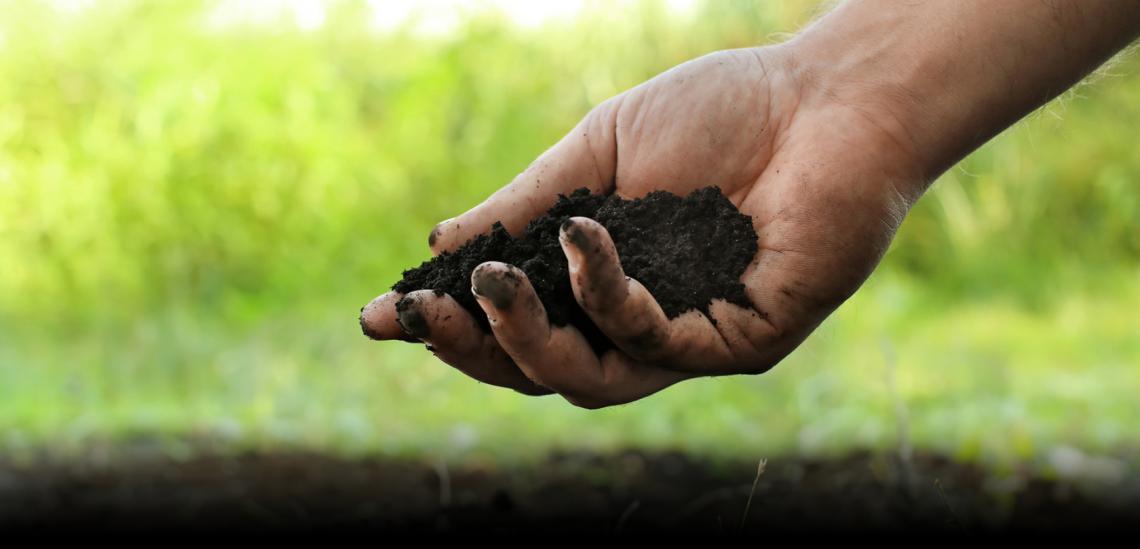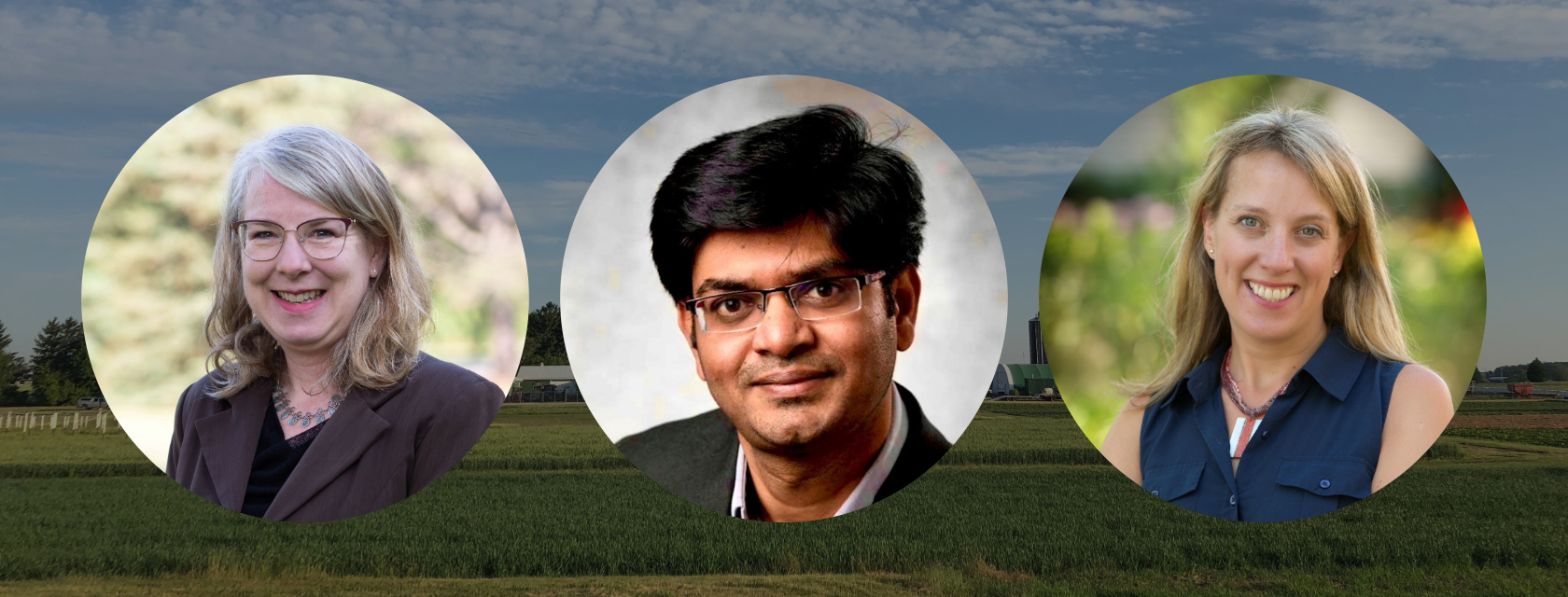Sector impact
The Ontario Agri-Food Innovation Alliance leverages the University of Guelph’s Soils at Guelph initiative to reach Ontario producers with the soil health knowledge and tools they need to make on-farm decisions.

![]()
The Ontario Agri-Food Innovation Alliance leverages the University of Guelph’s Soils at Guelph initiative to reach Ontario producers with the soil health knowledge and tools they need to make on-farm decisions.
Soil science knowledge generated by U of G researchers is moving beyond the field.
By leveraging the expertise centralized through the University’s Soils at Guelph initiative, the Ontario Agri-Food Innovation Alliance is helping soil health knowledge reach Ontario producers in new, creative ways.
“While there is no shortage of soil expertise out there, we see our role almost as ‘matchmakers’ of information,” says Heather White, communications and knowledge mobilization coordinator with Soils at Guelph. “We want to take knowledge flowing out from the University, then match it up with farming communities that are putting sustainable soil principles into practice.”
Leading Soils at Guelph are Dr. Kari Dunfield, Dr. Claudia Wagner-Riddle and Dr. Laura Van Eerd, all researchers in the Ontario Agricultural College’s School of Environmental Sciences.

Since 2018, their multidisciplinary team has been working to get soil science knowledge and research into the hands of growers and other stakeholders. As one Ontario grower who attended Soils at Guelph’s five-year celebration in December 2023 summarized, “Soils at Guelph continues to provide confirmation to us about our practices and provides more new information about the scientific effects on soil.”
Soil health is a priority for the Ontario Agri-Food Innovation Alliance, which provided early financial support to Soils at Guelph, including contributing to the Soil Health Interpretive Centre at the Ontario Crops Research Centre in Elora. The Alliance has funded more than 15 projects related to soil health since 2019.
Some of these projects, like those described below, are aimed at driving the transformation of research knowledge into use through the Alliance’s Knowledge Translation and Transfer (KTT) Mobilization funding stream. This financial support is critical to getting soil science knowledge and research onto farms and into communities, giving growers the tools they need to make decisions based on their unique situations.
The Ontario Soil and Crop Improvement Association (OSCIA) supports the sharing of Soils at Guelph’s knowledge mobilization products, including case studies and educational videos about best soil health practices, to its membership base of nearly 4,000 farmers.
“The Soils at Guelph initiative is a valuable complement to the OSCIA’s vision of farmers actively seeking, testing and adopting optimal farm production and stewardship practices,” says Dr. Angela Straathof, director of research and knowledge transfer at the OSCIA. “As an organization, we have benefitted from a valuable and mutually beneficial relationship with the initiative as Soils at Guelph has also provided valuable feedback to our own research and knowledge transfer endeavours.”
Here is how five Alliance-funded Soils at Guelph initiatives from the past five years are generating impact.
The Soils at Guelph team had planned a series of larger-scale, in-person extension events. The COVID-19 pandemic, however, pushed their outreach efforts online—and spurred plenty of creativity.
Dunfield points to the creation of a soil science-centric podcast, called “Talk Dirty to Me” and a three-part series of tongue-in-cheek educational videos about cover crops, “Cooking with Covers,” as two examples of their digital-first approach.

“We wanted to connect with growers and stakeholders on several different levels,” says Dunfield. “Our goal was to provide them with all the useful knowledge they’d get at an extension event, while keeping things fun and engaging.”
Another benefit? Growers had a wealth of soil science resources that they could access at their own pace.
“Rather than a single event, like a field extension day, we are able to have a lasting impact with our digital assets,” says Dunfield. “And we eliminated the need to ‘catch’ growers at the right time of the season with our messages when they may be busy with fieldwork.”
Another major output of the group’s Alliance-funded soil science knowledge mobilization efforts is a series of four case studies on soil health, biology, carbon and nitrogen.
These case studies each feature Ontario farmers, interweaving their stories and experiences with research.
"We wanted to go beyond presenting data,” says White. “We want it to be easy for someone to read through and clearly understand how they can apply key management practices like assessing soil health or incorporating cover crops in their own fields.
“The feedback from growers so far is that they love the more personalized approach because they’re getting information that’s more relevant to their growing conditions and experiences."
White adds that the case studies formed the basis of a four-part article series in Ontario Farmer, a popular agricultural newspaper read by 35,000 people.
Most agricultural fields in southern Ontario’s flat landscape employ some type of tile drainage system, but less understood is how water actually moves through soil and into tile drainage, as well as how different soil types influence this movement.
To help give growers a clearer understanding, Dr. Prasad Daggupati, researcher in the U of G School of Engineering, and his team have created a set of four interactive soil drainage models.
Each model is divided into two compartments, each with a different soil type, along with a rainfall simulator. This allows growers to see and compare water movement over time through soil to tiles.

“Of course, there are many factors at play when we get into specific soil types,” says Prasad. “If it’s sandy soil, we can see that water will tend to move faster and not stay on the soil surface. But if we’re on a clay, then water will hold and collect for longer on the soil surface—which can lead to erosion.”
Daggupati says the models are used at in-person extension events run by the Ontario Ministry of Agriculture, Food and Rural Affairs (OMAFRA) throughout the season. He and his team have also filmed their models and created a series of time-lapse videos online.
While the soil health benefits of cover crops are well known, what might be less obvious is which cover crops to use and in what part of the province.
With that in mind, Van Eerd and OMAFRA specialist Anne Verhallen struck an Ontario team to update and expand the online Cover Crop Decision Tool in collaboration with the Midwest Cover Crops Council.
The tool allows growers to pick from a list of more than 30 cover crops that best suit their cropping system, soil and region.
Van Eerd says growers can also narrow down their cover crop selection based on what they’re trying to achieve, say, fighting soil erosion, boosting organic matter content or reducing weeds.
“In updating the decision tool, we worked with growers, agronomic advisers, OMAFRA specialist staff, seed suppliers and conservation authorities to pull in Ontario-specific, validated information on agronomic practices, as well as the potential benefits and drawbacks of each cover crop,” she says.
Van Eerd and Soils at Guelph worked with industry specialists to create a series of downloadable cover crop “recipe cards” hosted on the Midwest Cover Crops Council’s website. The recipes are designed to help growers add cover crops.
“If you’re going from silage corn to soybeans the following season, there is a recipe that will guide you through planting a fall rye cover crop, for example,” says Van Eerd.
The cover crop recipe cards also gained recognition from the American Society of Agronomy, winning its “Outstanding Educational and Outreach Material” award in 2022.
Besides supporting the team’s outreach and knowledge exchange efforts, Alliance funding has enabled Soils at Guelph to train four highly qualified personnel (HQP).

“We’re supporting science communications in a very practical hands-on way by providing training that’s focused on writing, content creation and event management,” says White. “Along the way, there have been plenty of opportunities for our HQP to travel, meet stakeholders and experience Ontario’s dynamic soil-scape for themselves.”
White says they are continuing to build inroads with farming communities by acting as both an information hub and a listening ear.
Straathof agrees. “As OSCIA continues to expand our portfolio of research and knowledge transfer opportunities, ongoing and enhanced collaboration with Soils at Guelph would be of great benefit to farmers in search of practical soil health guidance.”
“We’re always focused on what is being asked of us—and how we are responding,” says White. “That’s helping us address their evolving needs and, ultimately, build our credibility. And that’s something we don’t take for granted.”
The Ontario Agri-Food Innovation Alliance is a collaboration between the Government of Ontario and the University of Guelph. The Ontario Crops Research Centre is owned by the Agricultural Research Institute of Ontario and managed by U of G through the Alliance.